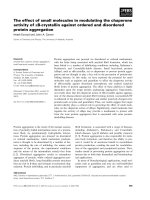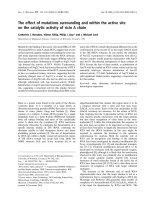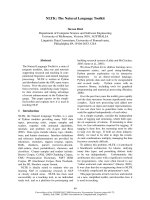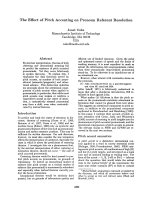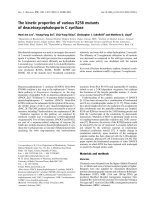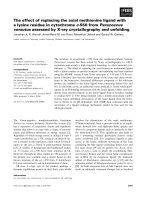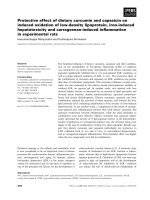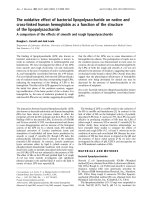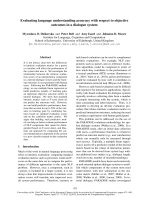Báo cáo khoa học: "The effect of various seed pretreatments to improve germination in eight indigenous tree species in the forests of Cameroon" docx
Bạn đang xem bản rút gọn của tài liệu. Xem và tải ngay bản đầy đủ của tài liệu tại đây (592.31 KB, 6 trang )
Original
article
The
effect
of
various
seed
pretreatments
to
improve
germination
in
eight
indigenous
tree
species
in
the
forests
of
Cameroon
Pierre
Marie
Mapongmetsem
Bahiru
Duguma
Bernard
Aloys
Nkongmeneck
Eric
Selegny
a
University
of
Ngaoundere,
Faculty
of
Science,
PO
Box
454,
Ngaoundere,
Cameroon
b
IRAD
/
ICRAF
Project,
PO
Box
2067,
Yaounde,
Cameroon
c
3125
Eccles,
Appartment
n°
Ogden,
UI
84403,
USA
d
University
of
Yaounde
I,
Faculty
of
Science,
PO
Box
812,
Yaounde,
Cameroon
e
University
of
Rouen,
PO
Box
76821,
Saint-Agnan,
France
(Received
28
December
1998;
accepted
12
April
1999)
Abstract -
Techniques
were
tested
for
improving
germination
in
eight
tree
species
indigenous
to
Cameroon
forests.
Manual
scarifi-
cation
was
the
most
efficient
treatment
for
all
species,
although
a
significant
interaction
between
treatment
and
species
was
found.
Only
one
species
was
sensitive
to
all
treatments.
The
use
of
sulphuric
acid
was
not
an
effective
alternative
to
manual
scarification.
©
1999
Inra/Éditions
scientifiques
et
médicales
Elsevier
SAS.
scarification
/
boiling
water
/
sulphuric
acid
/
sowing
depth
Resumé -
Effet
de
divers
prétraitements
sur
l’amélioration
de
la
germination
de
huit
essences
locales
des
forêts
camerounaises.
Des
études
ont
été
menées
sur
la
germination
de
huit
essences
agroforestières
indigènes
des
forêts
camerounaises.
La
scarification
manuelle
était
le
meilleur
traitement
pour
toutes
les
espèces,
bien
qu’il
existait
une
interaction
significative
entre
traitement
et
espèce.
Une
seule
espèce
a
été
sensible
à
tous
les
traitements.
L’utilisation
de
l’acide
sulfurique
n’a
pas
été
une
alternative
effective
à
la
sca-
rification
manuelle.
©
1999
Inra/Éditions
scientifiques
et
médicales
Elsevier
SAS.
scarification
/
eau
bouillante
/
acide
sulfurique
/
profondeur
de
semis
1.
Introduction
Rapid
population
growth
and
demands
for
increases
in
land
production,
especially
from
agriculture,
have
led
to
a
rapid
disappearance
of
tropical
rain
forests
and
to
land
scarcity
for
peasant
farmers
[11].
As
a
result,
the
*
Correspondence
and
reprints
Fax:
25
25
20
or
25
14
15
traditional
fallowing
system
is
disintegrating.
Fallow
periods
are
being
shortened
and
cropping
periods
lengthened.
This
leads
to
declining
soil
fertility,
falling
yields
and
a
serious
problem
of
weed
invasion
into
crop-
land.
These
substantial
constraints
reveal
the
need
to
introduce
a
land
use
system
which
can
allow
the
farm-
ers
to
save
the
forest
while
sustaining
agricultural
pro-
duction.
Some
agroforestry
technologies
(alley
farming,
fodder
banks,
simple
improved
fallow,
home
gardens,
live
fences)
have
been
developed
with
the
objective
to
improve
soil
fertility
and
reduce
the
fallow
period
through
the
use
of
nitrogen
fixing
trees
and
prunings
[7].
Most
agroforesry
trees
used
in
the
development
of
the
novel
technologies
are
exotic
(Cajanus
cajan,
Sesbania
sesban,
Crotalaria
anagyroides,
Calliandra
callothyrsus)
and
are
not
well
known
by
the
farmers.
However,
there
are
several
local
varieties
of
agroforestry
trees
including
Alstonia
boonei.De
Wild.,
Ceiba
pentandra
(L.)
Gearth.,
Cordia
platythyrsa
Bark.,
Milicia
excelsa
(Welw.)
c.c
Berg.,
Pycnanthus
angolense
(Welw.)
Warb.,
Ricinodendron
heudelotii
(Baill.)
Pierre
ex
Pax.,
Terminalia
superba
Engl.
&
Diels.
and
Triplochiton
scle-
roxylon
K.
Schum,
all
of
which
are
well
known
locally
as
sources
of
food,
fodder
timber
and
medicine,
but
their
potential
as
substitutes
for
the
exotics
has
not
been
inves-
tigated
[17,
18].
Even
less
is
known
about
propagating
them
from
seeds,
creating
a
serious
constraint
for
use
in
the
new
agroforestry
technologies.
Preliminary
studies
have
shown
that
they
have
generally
poor
germination
[15].
There
are
two
factors
which
influence
the
dorman-
cy
degree
of
the
seed:
1)
the
relative
maturity
of
the
seed
and
2)
the
humidity
level
during
maturation
[12,13].
The
author
suggests
also
that
the
dormancy
level
is
higher
in
drier
environments.
All
the
influences
which
occur
before
the
dispersion
are
’maternal
environment’
[22].
The
present
study
aimed
at
identifying
easily
applied
pretreatments
that
can
be
used
to
treat
large
quantities
of
seeds
to
assure
fast,
homogeneous
and
synchronised
ger-
mination.
One
specific
objective
was
to
overcome
the
dormancy
of
Ricinodendron
heudelotii.
The
underling
hypothesis
is
that
there
could
be
a
polymorphism
of
the
germination
behaviour
of
the
seeds
depending
on
the
pre-
sowing
techniques
applied.
2.
Materials
and
methods
2.1.
Description
of
location
The
study
site
is
located
in
humid
lowlands
of
Cameroon
(situated:
latitude
2°56’N-3°52’N;
longitude
11°32’E-11°57’E;
altitude
813
m).
According
to
data
collected
between
1980
and
1992,
mean
annual
rainfall
is
1
269
mm
usually
distributed
in
two
rainy
seasons
with
a
distinct
dry
period,
although
rainfall
pattern
varies
from
year
to
year.
The
average
temperature
is
23.4
°C;
while
relative
humidity
averages
75.1
%.
Ferralitic
soils
pre-
dominate.
Fallowing
is
the
most
commonly
used
tech-
nique
for
ameliorating
soil
fertility
on
farming
land,
the
main
crops
being
cassava,
groundnut
and
maize.
Poultry,
pigs
and
small
ruminants
are
the
major
domestic
source
of
animal
protein
in
the
region
[8].
2.2.
Selection
of
species
An
earlier
ethnobotanical
survey
carried
out
in
the
area
[8]
showed
that
local
farmers
had
good
knowledge
of
indigenous
agroforestry
species,
the
ten
most
promising
being
Ceiba
pentandra
(70
%
=
interviews
in
which
the
species
was
mentioned),
Terminalia
superba
(57
%),
Triplochiton
scleroxylon
(56
%),
Cordia
platythyrsa
(24
%),
Milicia
excelsa
(24
%),
Pycnanthus
angolense
(24
%),
Alstonia
boonei
(18
%),
Ricinodendron
heude-
lotii
(18
%),
Ficus
exasperata
(12
%)
and
Ficus
mucuso
(10.5
%).
In
the
present
paper
the
two
Ficus
species
were
excluded.
2.3.
Seeds
collection,
processing
and
handling
Seeds
for
all
species
were
collected
in
1992.
Mature
and
healthy
seeds
for
each
species
used
in
different
trials
were
from
four
seed
bearers.
After
harvesting,
they
were
mixed
in
view
of
minimising
inter
genetic
variations.
They
were
screened
and
handled
differently
according
to
their
morphological
structures.
In
T.
superba,
T.
sclerox-
ylon,
the
wings
of
the
seeds
were
removed.
Concerning
A.
boonei
and
C.
pentandra,
the
hair
and
cotton
were
removed,
respectively,
before
drying.
For
M.
excelsa,
fruits
were
crushed
by
hand
in
a
container
with
water,
fer-
tile
seeds
falling
to
the
bottom.
They
were
extracted
and
washed
several
times
with
water
from
the
cold
supply.
As
far
as
R.
heudelotii
is
concerned,
the
seeds
were
left
for
about
2
weeks
to
enable
disintegration
of
the
mesocarp
after
which
they
were
crushed
in
a
container
as
above.
The
seeds
were
washed
many
times
and
dried
for
about
4
weeks.
The
seeds
of
C.
platythyrsa
and
P.
angolense
were
collected,
extracted
and
dirt
removed,
then
pretreat-
ed
and
sown
immediately
because
they
are
refractory.
The
seeds
of
the
species
which
did
not
fall
into
this
cate-
gory
were
dried
in
the
open
for
2-4
weeks,
after
which
they
were
weighed
and
put
in
sealed
sample
bags
from
International
Board
of
Plant
Genetic
Resources
(IBPGR),
put
in
large,
dark
polythene
bags
and
conserved
in
the
freezer
(20-25
°C)
pending
the
sowing
period.
2.4.
Methodology
Seeds
were
germinated
in
petri
dishes
lined
with
filter
paper
sprayed
with
25
mL
of
water.
Ambient
temperature
in
the
laboratory
varied
from
25
to
30
°C.
The
treatments
used
were:
1)
seeds
soaked
for
12
h
in
water
from
the
cold
supply;
2)
seeds
soaked
for
3
min
in
boiling
water;
3)
seeds
soaked
in
approximately
0.5
L
of
98
%
sulphuric
acid
(just
enough
to
cover
the
seeds)
for
20
min,
and
stirred
every
3
min;
4)
seeds
hand
scarified
by
puncturing
the
seedcoats
at
both
the
micropyle
and
the
opposite
end;
and
5)
untreated
seeds
(control).
A
split-
plot
experimental
design
with
four
replications
was
employed.
The
main
components
were
species,
with
sub-
components
represented
by
the
various
treatments.
In
a
second
germination
trial
carried
out
on
R.
heude-
lotii,
seeds
were
soaked
in
sulphuric
acid
(98
%)
at
dif-
ferent
times:
20,
35,
45,
60,
75,
90
and
180
min.
The
experimental
design
was
a
randomised
complete
block
with
four
replications.
To
determine
the
effect
of
alternating
hot
and
cold
water
immersions
on
the
germination
of
R.
heudelotii,
seeds
were
soaked
as
follows:
1)
cold
(0
°C)
water
for
12
h;
2)
boiling
(100
°C)
water
for
3
min;
3)
cold
(0
°C)
water
for
12
h
followed
by
boiling
water
for
3
min
(0,
100
°C);
4)
boiling
water
for
3
min
followed
by
cold
water
for
12
h
(100,
0
°C);
5)
cold
water
for
12
min
fol-
lowed
by
boiling
water
for 3
min
followed
by
cold
water
for
12
h
(0,
100,
0
°C);
6)
boiling
water
for
3
min
fol-
lowed
by
cold
water
for
12
h
followed
by
boiling
water
for
3
min
(100,
0,
100
°C);
and
7)
no
treatment
(control).
Four
replications
were
tested
in
a
completely
randomised
block
design.
Concerning
the
test
of
the
effect
of
sowing
depth
on
germination
of
R.
heudelotii,
seeds
were
sown
in
a
poly-
ethylene
bag
containing
a
soil/sand
(70/30)
mixture
at
0,
2.5,
5
and
10
cm.
This
experiment
was
set
up
as a
ran-
domised
complete
block
design
with
four
replications.
For
each
of
the
above-mentioned
experiments,
the
experimental
unit
was
made
up
of
60
seeds.
The
first
two
experiments
were
carried
out
in
the
open
laboratory
under
ambient
conditions,
whereas
the
third
was
undertaken
in
the
nursery
ambient
conditions.
The
seed
was
considered
germinated
if
the
radicle
goes
through
the
seedcoat
in
the
first
two
experiments
and
when
the
seedling
appears
above
the
substrate for the
third
one.
Data
were
collected
at
3-day
intervals.
The
germination
duration
ranged
from
2
to
9
weeks.
The number
of
seeds
germinated
were
counted
and
the
percentage
germination
computed.
Variance
and
correla-
tions
were
calculated
using
the
statistical
package
Bstat.
Means
were
compared
using
Duncan’s
multiple
range
test
[10].
3.
Results
Highly
significant
(P
<
0.001)
differences
were
found
among
species
and
among
pretreatments,
resulting
in
a
highly
significant
species
x
treatment
interaction.
Germination
ranged
from
0
%
in
A.
boonei
seeds
treated
with
boiling
water
to
100
%
in
those
of
C.
platythyrsa,
M.
excelsa,
P.
angolense
and
T.
superba
that
had
been
hand
scarified
(table
I).
The
overall
mean
germination
for
hand
scarification
was
over
85
%,
indicating
that
this
was
the
most
efficient
treatment.
Whereas
seeds
of
most
species
responded
well
to
only
one
or
two
treatments,
seeds
of
C.
pentandra
were
sensitive
to
all
treatments.
Boiling
water
killed
most
if
not
all
the
seeds
of
A.
boonei,
C.
platythyr-
sa,
T.
superba
and
T.
scleroxylon,
but
not
those
of
C.
pen-
tandra,
M.
excelsa,
P.
angolense
and
R.
heudelotii,
while
sulphuric
acid
killed
the
seeds
of
A.
boonei,
M.
excelsa
and
P.
angolense
(table
I).
Similar
results
with
sulphuric
acid
have
been
reported
for
Casuarina
equisetifolia
even
after
a
5-min
immersion
[9].
However,
77.5
%
of
C.
platythyrsa
seeds
germinated
and
almost
64
%
of
T.
superba
when
soaked
in
acid
for
20
min
(table
I).
Cold
water
alone
had
very
little
effect
on
seeds
of
C.
platythyr-
sa
and
R.
heudelotii
but
had
varying
effects
on
the
other
species.
This
wide
variation
in
responses
to
the
treatments
indicates
considerable
differences
among
species
in
the
structure
of
the
seedcoat
as
protective
barrier.
Hand
scar-
ification
produced
100
%
germination
in
seeds
of
four
species,
demonstrating
that
once
the
seedcoat
had
been
scarified,
that
is,
punctured
at
both
ends,
water
and
oxy-
gen
were
able
to
move
into
the
seed
tissues
and
stimule
blastogeny.
The
entry
of
water
modifies
the
physiological
status
of
the
seed
[2].
Puncturing
at
the
micropyle
is
prob-
ably
significant
because
the radicle
then
encounters
least
resistance
to
its
elongation.
The
effectiveness
of
hand
scarification
in
enhancing
germination
in
the
species
studied
here
is
supported
by
observations
on
Terminalia
ivorensis
[1],
Leucaena
leu-
cocephala
[6],
Myrica faya
[ 14],
Tetrapleura
tetraptera
[19, 20],
Ricinodendron
heudelotii
[16],
Vitellaria
para-
doxa
and
Lophira
lanceolata
[18]
and
Canarium
schwe-
infurthii
[21].
In
this
study
hand
scarification
significant-
ly
increased
germination
rate
in
all
species.
Although
sul-
phuric
acid
had
been
recommended
as
one
of
the
best
treatments
to
overcome
seed
dormancy
in
some
species
[6],
the
results
from
the
first
experiment
did
not
confirm
this
for
R.
heudelotii
seeds.
This
may
have been
due
to
the
soaking
time
being
too
short.
In
a
second
experiment
the
soaking
time
in
sulphuric
acid
was
increased
up
to
180
min,
resulting
in
germination
from
0
%
for
soaking
dura-
tion
longer
than
60
min,
to
15
%
(maximum)
after
soak-
ing
for
60
min
(table
II).
Despite
the
differences
being
statistically
significant
(P
<
0.05),
germination
after
soak-
ing
in
sulphuric
acid
was
inferior
to
that
obtained
by
hand
scarification.
Soaking
time
in
acid
was
not
significantly
related
to
germination
(dl
=
6,
r
= -0.24,
P
>
0.05),
which
contrasts
with
the
effects
on
L.
leucocephala
in
which
germination
increased
with
longer
treatment
duration
up
to
60
min;
the
seedcoats
of
the
Euphorbiaceae
(R.
heude-
lotii)
is
tougher
than
that
of
the
Leguminoseae
(L.
leuco-
cephala).
When
seeds
of
R.
heudelotii
were
subjected
to
various
pretreatment
combinations
of
hot
and
cold
water,
no
clear
trend
in
germination
was
found
(figure
1).
No
significant
differences
between
treatments
occurred
during
the
first
3
weeks
after
planting,
but
differences
became
significant
after
the
4th
week.
Exposing
the
seeds
to
a
12-h
soak
in
cold
water
(0
°C)
followed
by
a
3-min
soak
in
boiling
(100 °C)
water
gave
the
best
germination,
approximately
65
%.
Other
combinations
of
hot
and
cold
water
treat-
ments
gave
less
than
50
%
germination
2
months
after
planting.
Changing
the
water
temperature
creates
a
mechanical
shock
which
causes
a
change
in
the
seedcoat,
thereby
facilitating
the
incursion
of
water
and
oxygen
indispensable
for
germination
[3].
It
was
observed
that
many
seeds
died
indicating
that
cold
or
hot
water
had
made
contact
with
the
embryos.
This
occurred
because
the
seedcoats,
which
normally
reg-
ulate
the
uptake
of
water,
had
been
damaged
and
the
rapid
increase
in
water
caused
irreversible
damage.
Germination
of
R.
keudelotii
seeds
increased
as
sow-
ing
depth
increased
(figure
2).
Best
germination,
60
%,
occurred
at
10
cm,
which
is
contrary
to
the
results
for
Metrosideros
polymorpha
in
which
germination
decreased
with
increasing
depth
[5].
Our
study
did
not,
however,
investigate
sowing
depths
beyond
10
cm.
4.
Discussion
Our
results
demonstrate
that
each
species
has
its
own
characteristic
set
of
germination
requirements
with
a
par-
ticular
threshold
of
response
according
to
its
peculiar
degree
of
heterochrony:
the
most
heterochronic
species,
the
seeds
of
which
are
subjected
the
most
to
environmen-
tal
variations
during
their
development,
will
present
the
highest
plasticity
response.
It
appears
that
hand
scarifica-
tion
significantly
improved
germination
in
all
species.
C.
pentandra
was
sensitive
to
all
treatments
while
R.
heude-
lotii
responded
to
only
a
few
treatments.
Hand
scarifica-
tion
could
be
regarded
as
a
feasible
alternative
to
sul-
phuric
acid
treatment.
However,
the
quantity
and
the
size
of
the
seed
can
be
a
constraint.
More
research
is
required
to
improve
the
efficiency
of
this
approach.
It
should
be
based
on
the
effects
on
germination
of
seed
maturity,
seed
position
on
the
branch
and
position
of
the
branch.
Acknowledgements:
Our
thanks
to
the
International
Centre
for
Research
in
Agroforestry
(ICRAF)
which
pro-
vided
funds
and
assisted
us
in
many
other
ways
for
the
work
described
here.
Dr
M.C.
Lawren
and
D. Parker
of
the
biometric
Unit
of
the
Institute
of
Agronomy
Research
gave
much
help
in
statistical
problems.
The
authors
are
also
indebted
to
two
anonymous
reviewers
who
edited the
manuscript.
References
[1]
Bibani
Mbarga,
Germination
du
Framiré,
Mémoire.
Ing.
Eaux
et
Forêts,
ENSA.
Nkolbisson,
Cameroun,
1983.
[2]
Chadœuf-Hannel
R.,
Barrelis
G.,
Influence
de
différents
régimes
hydriques
sur
la
croissance
végétative,
le
poids
et
la
germination
des
graines
d’une
mauvaise
herbe
cultivée
en
serre
Amaranthus
retroflexus
L.,
Rev.
Agron.
9
(1982)
279-302.
[3]
Côme
D.,
Les
obstacles
de
la
germination,
Masson,
Paris,
1970.
[4]
Dialla
I.,
Danthu
P.,
Sambou
B.,
Dibor
D.,
Goudiaby
A.,
Poulsen
K.,
Effects
of
different
pretreatments
on
the
germina-
tion
of
Faidherbia
albida
(Del.)
A.
Chev.
seeds,
Int.
Tree
Crops
J
9
(1996)
31-36.
[5]
Donald
Drake
R.,
Germination
requirements
of
Metrosideros
polymorpha,
the
dominant
tree
of
Hawaii
in
lava
flows
and
rain
forests.
Hawaii,
USA,
Biotropica
27
(4)
(1993)
461-467.
[6]
Duguma
B.,
Study
of
factors
affecting
establishment
of
selected
tree
species
of
potential
importance
in
Agroforestry,
Ph.D.
thesis,
Ibadan,
Nigeria,
1985.
[7]
Duguma
B.,
Mollet
M.,
Provenance
evaluation
of
the
Calliandra
calothyrsus
Meissner
in
the
humid
lowlands
of
Cameroon,
Agrofor.
Syst.
37
(1997)
45-57.
[8]
Duguma
B.,
Tonye
J.,
Depommier
D.,
Diagnostic
survey
on
local
multipurpose
tree
shrubs,
fallows
systems
and
livestock
in
South
Cameroon,
Working
paper
60,
1990.
[9]
Eze
J.M.O.,
Ahonsi
M.O.,
Improved
germination
of
the
seeds
of
whistling
pine
(Casuarina
equisetifolia)
Forst
and
Forst
(Casuarinaceae)
by
various
presowing
treatments,
Agronomie
13
(1993)
889-894.
[10]
Finney
D.J.,
An
Introduction
to
Statistical
Science
in
Agriculture,
4th
ed.,
Monksgaard,
1972.
[11]
Floquet
A.,
Conservation
of
soil
fertility
by
peasant
farmers
in
Atlantic
Province,
Benin,
in:
Kotschi
J.
(Ed.),
Ecofarming
Practices
for
Tropical
Smallholdings.
Tropical
Agroecology
5,
Weikershein,
Germany,
1990,
pp.
29-53.
[12]
Karssen
C.M.,
Environmental
conditions
and
endoge-
nous
mechanisms
involved
in
secondary
dormancy
of
seeds,
Isr.
J.
Botany
29
(1981)
45-64.
[ 13]
Karssen
C.
M.,
Patterns
of
change
in
dormancy
during
burial
of
seeds
in
soil,
Isr.
J.
Bot.
29
(1981)
65-73.
[14]
Lawrence
R.,
Walker,
Germination
of
an
East
African
invading
trees
species
(Myrica
faya)
in
Hawaii,
USA,
Biotropica
22
(2)
(1990)
140-147.
[15]
Mapongmetsem
P.M.,
Phénologie
et
modes
de
propaga-
tion
de
quelques
essences
locales
à potentiel
agroforestier
en
zone
forestière,
thèse,
Univ.
Yaoundé
I,
Cameroun,
1994.
[16]
Mapongmetsem
P.M.,
Duguma
B.,
Nkongmeneck
B.
A.,
Domestication
of
Ricinodendron
heudelotii
in
humid
low-
lands
of
Cameroon,
in:
Kapseu
C.,
Kayem
G.J.,
(Eds.),
Proc.
2nd
Int.
workshop
on
African
pear
(Dacryodes
edulis)
improve-
ment
and
other
new
sources
of
vegetable
oils,
Ngaoundere,
Cameroon,
1997,
pp.
25-34.
[ 17]
Mapongmetsem
P.M.,
Duguma
B.,
Nkongmeneck
B.A.,
Selegny
E.,
Phénologie
de
quelques
essences
à usages
multiples
de
la
zone
forestière,
in:
Duguma
B.,
Mallet
B.
(Eds.),
Actes
Symp.
Int.
Recherche
et
Développement
en
Agroforesterie
en
zone
forestière
de
l’Afrique
Centrale
et
de
l’Ouest.
Yaoundé,
Cameroun,
1995,
pp.
69-80.
[18]
Mapongmetsem
P.M.,
Tchiengang-Megueni
C.,
Akagou
Zedong
H.
C.,
Nyomo
et
Laissou
Moussou,
Inventaire
et
essai
de
domestication
de
quelques
oléagineux
locaux
du
Cameroun,
in:
Kapseu
C.,
Kayem
G.J.,
(Eds.),
Actes
2nd
Séminaire
International
sur
l’amélioration
du
Safoutier
(Dacryodes
edulis)
et
autres
oléagineux
non
conventionnels,
Ngaoundere,
Cameroun,
1997,
pp.
13-24.
[19]
Mbolo,
Germination
et
croissance
des
essences
forestières
du
Sud-Cameroun.
Exemple
de
quelques
Légumineuses
et
Sapotacées,
thèse,
Univ.
Yaoundé
I,
Cameroun.
1990.
[20]
Ndemmeze
A.R.A.,
Germination
in
vitro
et
croissance
en
pépinière
de
Tetrapleura
tetraptera
(Schum
and
Thonn),
influence
de
la
position
de
la
graine
dans
la
gousse,
du
poids
et
de
la
scarification,
mémoire,
Univ,
Yaoundé
I,
Cameroun.
1992.
[21]
Njoukam
P.,
Germination
et
croissance
de
l’Aiélé
(Canarium
schweinfurthii),
in:
Kapseu
C.,
Kayem
G.J.
(Eds.),
Actes
2nd
Séminaire
International
sur
l’amélioration
du
Safoutier
(Dacryodes
edulis)
et
autres
oléagineux
non
conven-
tionnels,
Ngaoundere,
Cameroun,
1997,
pp.
45-54.
[22]
Roach
D.,
Wulff R.D.,
Maternal
effects
in
plants,
Annu.
Rev.
Ecol.
Syst.
18
(1987)
209-235.
